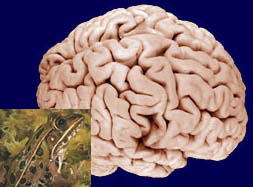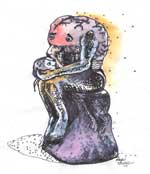
Biology 202
Neurobiology and Behavior
Spring 2006


| Biology 202 | 
|
To facilitate posting web projects, they will need to be turned in in an electronic form prepared for posting, as well as in hard copy. The material below is intended to make it as easy as possible to go from a standard word processing document (to be turned in as hard copy) to an HTML document ready for posting. If you are used to preparing web documents in some other way, please see note at end.
Step 1
Write your paper as you normally would, with a numbered list of web (URL, and name of site) and other references at the end, and with citations to that list shown in the text as numbers within parentheses. Print for hard copy. An example is shown below:
Information about Biology 202Paul GrobsteinAmong the available course resources on Serendip is a forum area (4), where students write weekly comments on material of the course. Each week's comments are moved to their own file, which can be reached by clicking on a topic list at the end of the course home page (1).
1) http://serendipstudio.org/bb/neuro/neuro03; Biology 202 home page, on the Serendip web site 2) http://serendipstudio.org; Serendip, the server home page. 3) Damasio, Antonio. The Feeling of What Happens. New York: Harcourt Brace, 1999. 4) http://serendipstudio.org/bb/neuro/neuro03/forum-neuro03.html; Biology 202 forum area, on the Serendip web site |
Step 2
Make a second version of your paper by saving the original version as "text only". Give it a distinctive name, such as name.txt. This version will lose some formatting characteristics, such as underlining and boldfacing. If will also lose text layout features such as tabs and tables (so try and avoid using these in your original paper, unless you are familiar with HTML tags and can add these later yourself). If paragraphs are not separated by an empty line in the text only version, add a carriage return after each paragraph.
Replace each location in the text where you cite a reference with <a href="#REFERENCE NUMBER">(REFERENCE NUMBER)</a> . For example, (1) is replaced with <a href="#1">(1)</a>.
Replace each item in your reference list with one of the following, as appropriate.
For web references:
Use <a name="REFERENCE NUMBER">REFERENCE NUMBER)</a><a href="URL OF WEB REFERENCE">NAME OF YOUR WEB REFERENCE SITE</a>, COMMENTS ABOUT IT
An example:
<a name="5">5)</a><a href="http://serendipstudio.org">Serendip Home Page</a>, a rich resource from Bryn Mawr College
For non-web references:
Use <a name="REFERENCE NUMBER">REFERENCE NUMBER) STANDARD PRINT REFERENCE FORMAT
An example:
<a name="7">7) Damasio, Antonio. The Feeling of What Happens. New York: Harcourt Brace, 1999.
Resave your text only document. Close it and reopen it before going on to the next step, to be sure you use the text only document for cutting and pasting.
Step 3
Go to the web paper posting area. Enter your email address, and your full name and paper title as you want them to appear in the posted version.
Copy and paste the body of your text only paper into the text entry window, leaving out the title and your name which will be added from the information you've already proved. The text entry window contains a preformatted HTML template for your paper. Be sure you have made needed changes for each place in the text where you make a citation with a number in parentheses, and for each item in your reference list. Also remember there needs to be an empty line between paragraphs.
ENDNOTE. If you have experience with web-authoring, you are welcome to supplement the above by adding images and/or other links within the text. If you want to construct the body of your paper in a way that includes all needed HTML tags, including those for paragraph and line breaks (so as to create special layouts using tabs and tables) then you should change the "Paper formatted as" setting from "plain text" to "HTML".
| Course Home Page
| Course Forum | Brain and
Behavior | Serendip Home |
Send us your comments at Serendip
![]()
© by Serendip 1994-
- Last Modified:
Wednesday, 02-May-2018 11:57:52 CDT